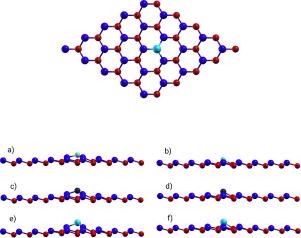含两性杂质(Si, Ge, Sn)的二维GaAs单层的电子和光学性质的DFT计算
IF 3.9
Q3 PHYSICS, CONDENSED MATTER
引用次数: 0
摘要
二维材料由于其卓越的电子、光学和化学性质,在当代研究中已成为高度相关的元素。突出的例子包括石墨烯、硅烯、磷烯、硼烯等。此外,二维砷化镓也在此背景下进行了研究,研究了异质结构和单层结构,在电子、光学(包括非线性现象)、光催化和气体吸附等领域具有潜在的应用。根据这一研究趋势,本工作给出了二维砷化镓单层的能带结构、态密度(DOS)和光学响应的结果,包括其原始状态和两性取代杂质,如硅(Si)、锗(Ge)和锡(Sn),并考虑了自旋极化。分析清楚地揭示了杂质对能带的影响,根据杂质的类型(n型或p型),可以观察到接近导(或价)带的能级。在态密度(DOS)中,杂质对自旋极化的影响是明显的,表明在费米能级附近n型出现了两个不对称态(一个为自旋向上,另一个为自旋向下),而p型只观察到一个(自旋向下)。同样,分析了电磁波谱可见区域的吸收系数和反射率,揭示了杂质引起的变化。这些发现为未来的应用和进一步的研究提供了重要的信息。本文章由计算机程序翻译,如有差异,请以英文原文为准。

DFT calculation of the electronic and optical properties of a 2D GaAs monolayer with amphoteric impurities (Si, Ge, and Sn)
Two-dimensional materials have emerged as highly relevant elements in contemporary research due to their remarkable electronic, optical, and chemical properties. Prominent examples include graphene, silicene, phosphorene, borophene, among others. Additionally, two-dimensional gallium arsenide has been studied in this context, investigated both in heterostructures and monolayers, with potential applications in fields such as electronics, optics (including nonlinear phenomena), photocatalysis, and gas adsorption, among others. In line with this research trend, this work presents results on the band structure, density of states (DOS), and optical responses of a monolayer of 2D gallium arsenide, both in its pristine state and with amphoteric substitutional impurities, such as silicon (Si), germanium (Ge), and tin (Sn), considering spin polarization as well. The analysis clearly reveals the effect of impurities on energy bands, where levels close to the conduction (or valence) band are observed, depending on the type of impurity (-type or -type). In the density of states (DOS), the impact of impurities in relation to spin polarization is evident, showing the emergence of two asymmetric states for -type near the Fermi level (one for spin up and another for spin down), while for -type only one is observed (for spin down). Likewise, absorption coefficient and reflectance in the visible region of the electromagnetic spectrum are analyzed, revealing impurity-induced changes. These findings provide crucial information on properties relevant for future applications and further studies.
求助全文
通过发布文献求助,成功后即可免费获取论文全文。
去求助
来源期刊

Computational Condensed Matter
PHYSICS, CONDENSED MATTER-
CiteScore
3.70
自引率
9.50%
发文量
134
审稿时长
39 days
 求助内容:
求助内容: 应助结果提醒方式:
应助结果提醒方式:


